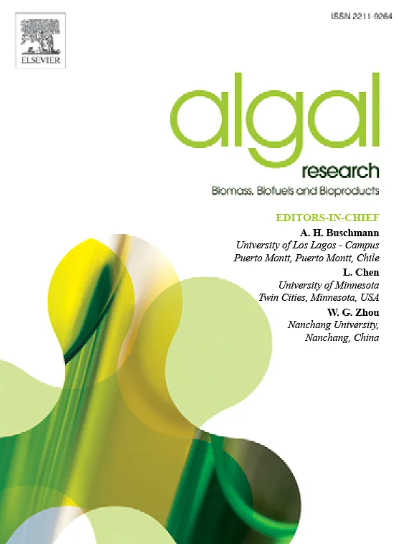High yield isolation of lutein from high water content Chlorella Vulgaris: A water-plasma and three-phase partitioning approach
IF 4.6
2区 生物学
Q1 BIOTECHNOLOGY & APPLIED MICROBIOLOGY
Algal Research-Biomass Biofuels and Bioproducts
Pub Date : 2025-03-17
DOI:10.1016/j.algal.2025.104008
引用次数: 0
Abstract
Extracting lutein from microalgae is a promising approach for lutein production due to the unique advantages of microalgae than terrestrial plants, including superior photosynthetic efficiency, rapid growth rate and potential for carbon mitigation. However, conventional extraction methods from microalgae usually include the utilization of traditional solvents or harsh reaction conditions, resulting in environmental impact and high energy consumption. To address these challenges, an innovative strategy integrating water-plasma with three-phase partitioning (TPP) methods has been proposed for extracting lutein from high water content microalgae. This approach utilizes the reactive species generated by water-plasma, which interact effectively with algal cellular components, while TTP further improved extraction efficiency. Under optimized conditions of 12.9 % DKP concentration, 176.9 W treatment power and 8.8 min treatment time of this method achieved a maximum lutein extraction yield of 0.287 mg/g microalgae. Importantly, this lutein production process eliminates the need for the drying of microalgae biomass, thereby significantly diminishing energy consumption and enhancing the economical scalability of lutein production.

求助全文
约1分钟内获得全文
求助全文
来源期刊

Algal Research-Biomass Biofuels and Bioproducts
BIOTECHNOLOGY & APPLIED MICROBIOLOGY-
CiteScore
9.40
自引率
7.80%
发文量
332
期刊介绍:
Algal Research is an international phycology journal covering all areas of emerging technologies in algae biology, biomass production, cultivation, harvesting, extraction, bioproducts, biorefinery, engineering, and econometrics. Algae is defined to include cyanobacteria, microalgae, and protists and symbionts of interest in biotechnology. The journal publishes original research and reviews for the following scope: algal biology, including but not exclusive to: phylogeny, biodiversity, molecular traits, metabolic regulation, and genetic engineering, algal cultivation, e.g. phototrophic systems, heterotrophic systems, and mixotrophic systems, algal harvesting and extraction systems, biotechnology to convert algal biomass and components into biofuels and bioproducts, e.g., nutraceuticals, pharmaceuticals, animal feed, plastics, etc. algal products and their economic assessment
 求助内容:
求助内容: 应助结果提醒方式:
应助结果提醒方式:


